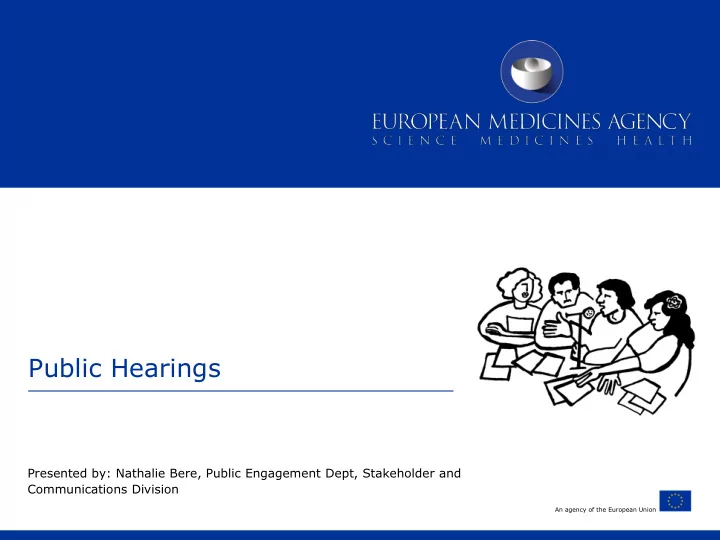

Public Hearings Presented by: Nathalie Bere, Public Engagement Dept, Stakeholder and Communications Division An agency of the European Union
Key principles PRAC can hold public hearings in the context of safety referral procedures (Article 20 • of Regulation (EC) 726/2004, Article 31 or 107i of Directive 2001/83/EC) Public is invited to express its views, guided by a pre-defined set of questions • Any member of the public can apply to attend as a speaker or an observer; if the • number of requests is greater than can reasonably be accommodated only the most appropriate applications will be selected based on PRAC questions and focus of the hearing Public hearings complement EMA’s existing channels for engaging with patients and • healthcare professionals in the assessment of medicines, such as written consultations and participation in EMA expert meetings during safety reviews. 1
Aims of a public hearing Increase transparency by opening up the scientific evaluation The aim is to listen to and take into account the perspectives Empower of the public once all available citizens Add value data and evidence has been Trust by giving to the collected and assessed and risk them a voice evaluation minimisation actions are being in the process evaluation of considered. medicines Improve public understanding of scientific and regulatory process 2
Key characteristics At the start of each referral PRAC will consider need to hold a public hearing (can • also decide later), based on; Feasibility in light of urgency of matter • Nature and extent of safety concern • Therapeutic effect of medicine and availability of alternatives • Potential impact of regulatory actions • Level of public interest • Conducted in English • If speakers unable to present in English, EMA can provide translation • 3
Organisation of a public hearing Preparation • Announced on website • Summary of issues & • Chaired by PRAC Chair Specific questions • Rapps overview of • Date and time issues / questions • Review requests • Registration information • Draw up list of • Speakers DOI & speakers /observers interventions according to group and • Broadcast live & relevance recorded • Allocate time slots Announcement Conduct 4
Dry Run A dry run was held in July to prepare for possible scenarios, to fine-tune the process and • finalise guidance for participants and PRAC members/EMA staff Approximately 75 EMA staff volunteered (speakers and observers) • 5 speakers (3 patients, 1 industry, 1 healthcare professional) → 60-65 observers → Fictitious medicine used • Overall conclusions and feedback confirmed that processes put in place generally worked • well; some fine tuning is required but no major problems identified. 5
Next steps • Public consultation • Adoption and publication of Rules of Procedure April- July • Dry run’ public hearing with EMA staff July • Finalisation of internal & external guidance documents August • Ready for implementation Sept 6
Recommend
More recommend